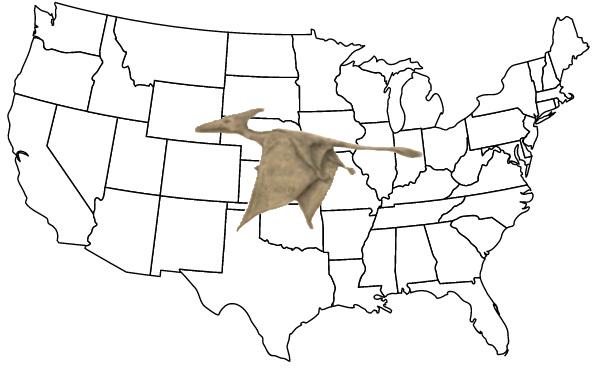By the modern pterosaur expert Jonathan Whitcomb
Where in the United States would you be most likely to see a non-extinct pterosaur, what many Americans might call a “pterodactyl sighting?” Before Christmas day of 2017, I would’t have had an answer for you. I’ve been receiving emails and phone calls from across the country for 13 years, and it seemed like almost any state of the USA would be almost as good as any other state. But the Living Pterosaurs Declaration page gives 161 sightings (as of December 25, 2017) in 34 areas where persons have seen these flying creatures across the country: It lists thirty-three states and Washington D.C.
Surprises for Jonathan Whitcomb
I had long known that California and Texas have been hot spots for pterosaur sightings, including encounters with ropens, some of which have been large flying creatures. But when I did simple statistical analysis based upon human populations, I found that California was only slightly above average for LP sightings and Texas was only slightly below average. Considering how many humans live in those two states, the number of sighting reports of apparent living pterosaurs is nothing extraordinary for those two states.
Correlated with human populations, the hot spots are in Hawaii and Utah. I was not expecting that. Third place goes to Oklahoma, a state with fewer humans than average in the USA but apparently a good share of “pterodactyls.” It seems that the state of New York is at the bottom of the barrel for the number of persons who send in reports to cryptozoologists, but on looking a little deeper, I see that five pterosaur sightings in New York state were not included in the declaration page. If those other five are added to the one, it gives a ration of 1.9 sighting reports per 6-million humans: well below average (3.1) but far above the bottom. Not surprisingly, while working in an office in a skyscraper in Manhattan, nobody reports a pterodactyl flying by the window. Like the rest of the country, the best place to be for a sighting of a pterosaur in New York state is out of doors.
.

Listing of Statistics as of December 25, 2017
Number of reported sightings per 6-million humans living in the USA (average across the country = 3.1):
Hawaii (ten) = 44.1
Utah (nine) = 19.5
Oklahoma (seven) = 11.2
Washington D.C. (one) = 10.0
Kansas (four) = 8.4
Arkansas (four) = 8.3
Virginia (ten) = 7.5
Georgia (twelve) = 7.4
West Virginia (two) = 6.5
Washington state (seven) = 6.2
Montana (one) = 6.1
South Carolina (four) = 5.2
Oregon (three) = 4.7
Maine (one) = 4.5
California (twenty-seven) = 4.3
Louisiana (three) = 4.0
Mississippi (two) = 4.0
Idaho (one) = 3.8
North Carolina (six) = 3.8
Ohio (seven) = 3.6
Wisconsin (three) = 3.2
Missouri (three) = 3.0
New Mexico (one) = 2.9
Arizona (three) = 2.8
Pennsylvania (six) = 2.8
Texas (eleven) = 2.6
Minnesota (two) = 2.3
Florida (five) = 1.6
Kentucky (one) = 1.4
Alabama (one) = 1.3
Massachusetts (one) = 0.9
New Jersey (one) = 0.7
Michigan (one) = 0.6
New York (one) = 0.3 (*but when updated to six sightings it is 1.9)
.
*Additional notes on these statistics
The above comparisons are based upon version 056 of the “Declaration on Eyewitness Reports of Apparent Living Pterosaurs” (published on flying-creature.com), dated December 14, 2017. Revisions are expected in 2018, and probably after that, which may change at least some of the above numbers. With that said, it seems unlikely that the dominant states, like Hawaii and Utah, will be unlikely to change drastically in their positions during the updating which is expected in the year 2018. Please be aware of the following:
- New sighting reports come in
- Old reports that were not included in version-056 may be added
###
.
I have encountered several sighting reports from Hawaii this year [2012] (mostly either email or blog-post comment I’ve received from eyewitnesses). But the encounter described in a post of the s8intcom blog now deserves attention and comparison with other sightings in Hawaii.
.
On August 13, 2015, I received an email from an eyewitness living South of Provo, Utah. It confirms earlier reports of apparent pterosaurs in Utah, especially nocturnal flying creatures that are very large.
.
Pterosaur sighting in Oklahoma
. . . a truck driver who witnessed what seems to have been a ropen, in Oklahoma, just yesterday.
.
Pterodactyl encounter in Kansas
I have a feeling we’re not in Papua New Guinea anymore
.
. . . we have two sightings, separated by about five years.
.


